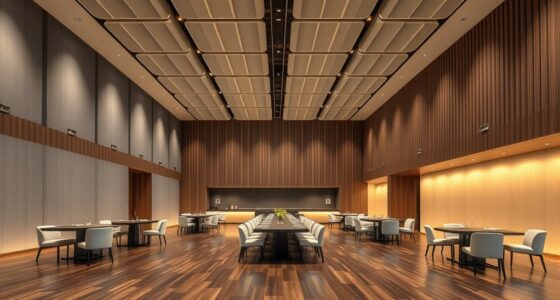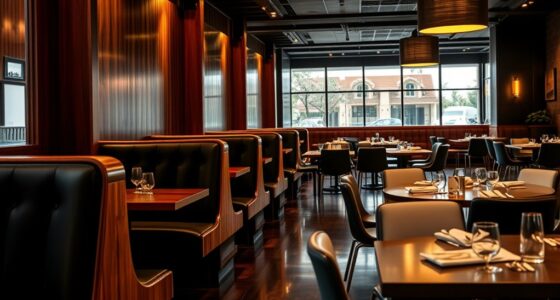Restomod in the culinary scene involves transforming historic restaurant spaces by combining their original charm with modern design, technology, and sustainable practices. You’ll see features like preserved facades, vintage signage, and exposed brick paired with sleek lighting, contemporary furniture, and energy-efficient systems. This approach respects heritage while appealing to today’s diners, creating inviting spaces full of character and innovation. Keep exploring to discover how this trend continues to shape vibrant, community-focused eateries.
Key Takeaways
- Restomod in restaurants combines preserving historic architecture with modern design and technology upgrades to enhance appeal and functionality.
- Key elements include maintaining original features while incorporating contemporary lighting, furniture, and sustainable materials.
- Balancing preservation and innovation fosters authentic, inviting spaces that respect heritage and meet current consumer preferences.
- Challenges involve regulatory restrictions, sourcing authentic materials, and managing budgets during renovation projects.
- Future trends focus on eco-friendly practices, smart technology integration, and community engagement to create versatile, culturally rich venues.
The Origins of Restomod in the Culinary Scene
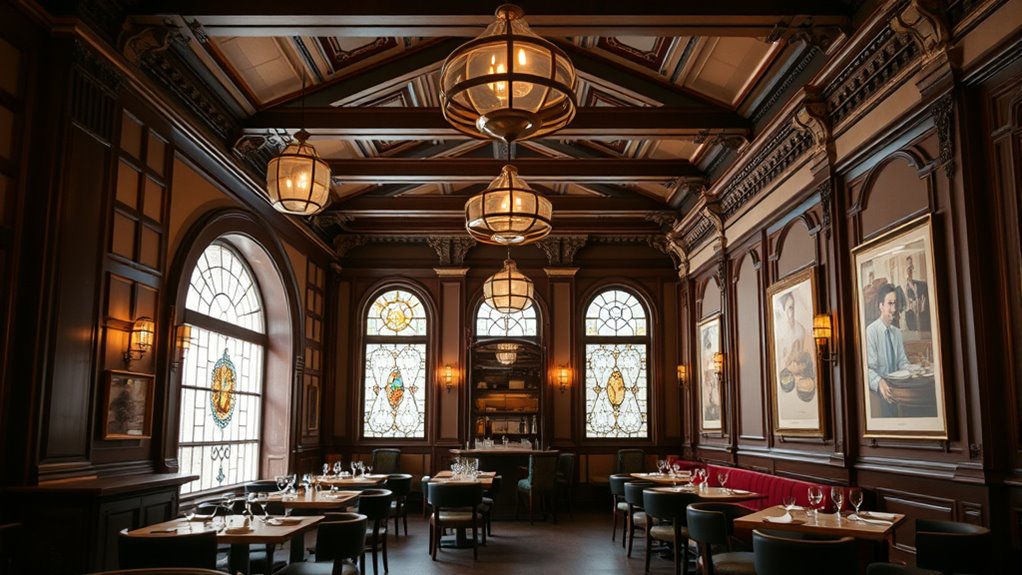
Restomod, a term borrowed from the automotive world, has found its way into the culinary scene by emphasizing the transformation of historic restaurant spaces. Originally, restomod referred to restoring vintage cars with modern upgrades, blending old-school charm with new technology. Chefs and restaurateurs adopted this concept to revitalize historic venues, respecting their heritage while adding contemporary touches. This approach gained popularity in the early 2000s when owners sought to preserve architectural significance amid modernization trends. By combining preservation with innovation, restomod became a way to attract diners seeking authenticity without sacrificing comfort or style. Its roots lie in a desire to honor the past while adapting to current tastes, creating a dynamic balance that breathes new life into old spaces.
Key Elements of Restomodding Historic Restaurants

Transforming historic restaurants requires a careful balance of preservation and innovation, focusing on key elements that define successful restomodding. First, you need to respect the building’s original architecture, maintaining signature features like facades, moldings, or historic signage. Simultaneously, you incorporate modern elements such as updated lighting, sleek furniture, or contemporary art to enhance functionality and appeal. Material choices are vital; blending vintage materials with new, durable options creates harmony between old and new. Layout adjustments should improve flow and capacity without sacrificing character. You also integrate modern technology discreetly, ensuring seamless service and ambiance. Ultimately, your goal is to honor the past while creating a space that feels fresh, welcoming, and relevant to today’s diners.
Balancing Preservation and Innovation
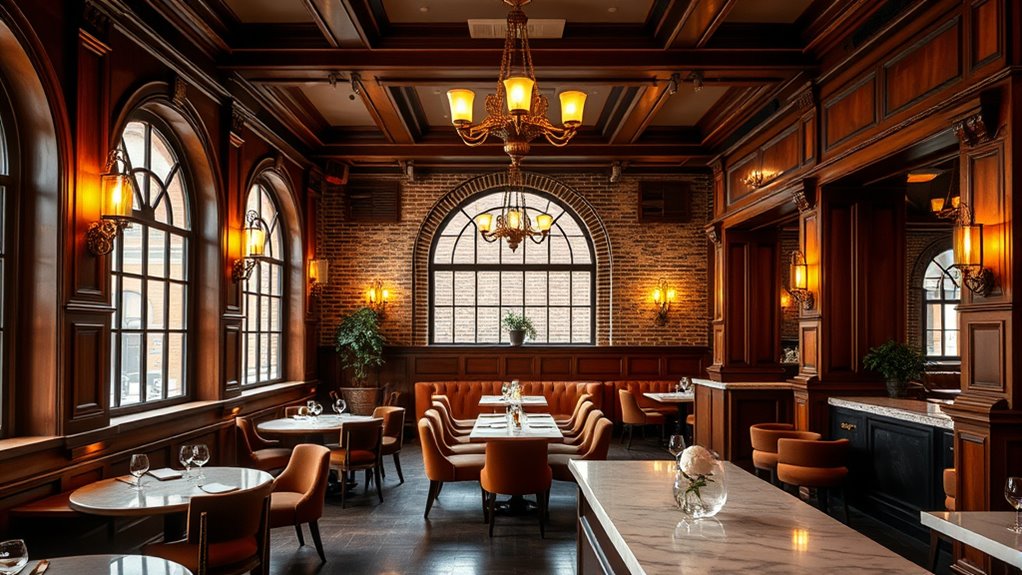
Balancing preservation and innovation is essential to successfully revamping historic restaurant spaces. You need to honor the building’s original charm while introducing modern updates that enhance functionality and appeal. Start by identifying key architectural features worth conserving, like historic facades, moldings, or fixtures. These elements serve as a connection to the past and create a sense of authenticity. Then, find innovative ways to incorporate contemporary design and technology that improve the dining experience without overwhelming the historic character. Using subtle contrasts—like blending old brick with sleek lighting—helps achieve harmony. Remember, your goal isn’t to create a museum piece but a vibrant space that respects history while embracing the present. Incorporating vintage decor and other authentic elements can further reinforce the historic feel while allowing for creative updates. Striking this balance ensures your restoration feels authentic, fresh, and inviting.
Design Trends in Restomodded Eateries
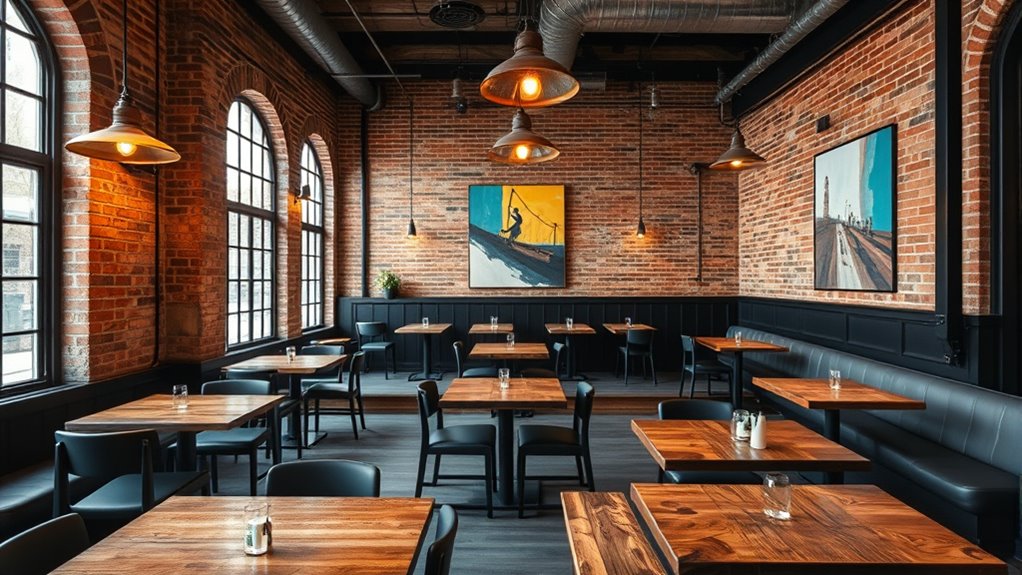
You’ll notice that restomodded eateries often blend vintage charm with sleek modern aesthetics to create a unique atmosphere. Sustainable materials are gaining popularity, helping you enjoy style without sacrificing eco-consciousness. Bold statement lighting then ties the look together, making the space both inviting and striking. Incorporating renewable energy sources into the design can further enhance the eco-friendly appeal of these spaces.
Vintage Meets Modern Aesthetics
Vintage and modern aesthetics now blend seamlessly in restomodded eateries, creating spaces that honor history while feeling fresh and inviting. You’ll notice authentic architectural details, like exposed brick or vintage signage, paired with sleek furniture and contemporary lighting. This contrast highlights the building’s past while embracing current design sensibilities. You might see retro-inspired color palettes combined with minimalist decor, striking a balance between nostalgia and innovation. The goal is to evoke a sense of familiarity while offering a fresh experience. Restomodded spaces invite you to enjoy the charm of yesteryear without sacrificing comfort or style. This fusion not only preserves the character of historic sites but also makes them relevant and appealing for today’s diners. Incorporating historic preservation elements ensures the longevity and cultural significance of these venues, making them enduring landmarks. It’s a thoughtful dance between the old and new.
Sustainable Material Choices
As restaurateurs seek to honor both history and sustainability, choosing eco-friendly materials has become a key trend in restomodding historic spaces. You’ll find that reclaimed wood, recycled metal, and sustainable stone are popular choices, blending authenticity with eco-consciousness. Using materials like bamboo or cork for flooring reduces environmental impact while adding warmth and texture. Low-VOC paints and natural sealants improve indoor air quality, aligning with green building practices. You might incorporate recycled glass tiles or salvaged fixtures to preserve historic charm while supporting sustainability. These choices not only minimize your restaurant’s carbon footprint but also tell a story of respect for the environment and heritage. Incorporating nutrient retention in your material selection ensures that the natural qualities of the materials are preserved, supporting both sustainability and aesthetic appeal. Sustainable materials help you create a space that’s both stylish and responsible, appealing to eco-aware patrons.
Bold, Statement Lighting
Bold, statement lighting has become a defining feature in restomodded eateries, transforming ordinary spaces into memorable destinations. You’ll notice oversized pendant lights, vintage chandeliers, or sculptural fixtures that immediately draw the eye. These lighting choices set the mood and highlight architectural details or design elements. You’re encouraged to experiment with contrasting styles—mixing industrial pipes with sleek modern bulbs or vintage fixtures with contemporary accents—to create a unique atmosphere. Dimmable lighting adds flexibility, allowing you to adjust ambiance throughout the day. Color temperature adjustments can enhance the overall aesthetic and mood of the space. Statement lighting not only enhances visual interest but also communicates the restaurant’s personality. By choosing bold, eye-catching fixtures, you help elevate the space from simply functional to a memorable experience that keeps guests talking long after they leave.
Case Studies of Successful Restomodded Restaurants
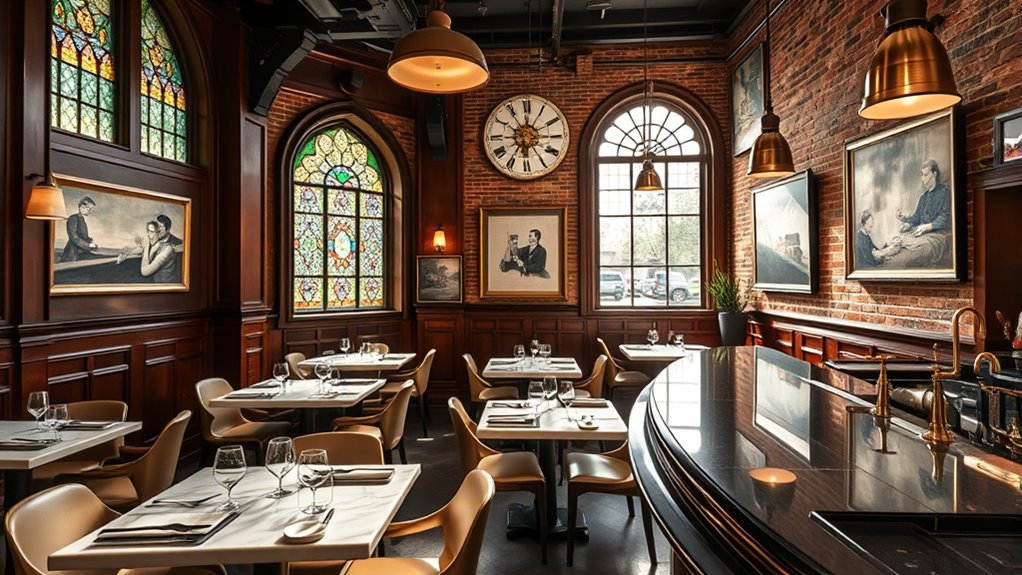
Across the globe, restaurateurs are breathing new life into historic spaces by combining their unique character with modern design, resulting in successful restomodded establishments. Take, for example, The Redford in New York, where vintage brick walls and original fixtures blend seamlessly with sleek, contemporary furniture, creating an inviting atmosphere. In Berlin, the Zum Alten Fritz preserved its 19th-century façade while updating the interior with minimalist décor and energy-efficient lighting. Meanwhile, The Old Mill in London maintained its historic charm with exposed beams and stonework, complemented by modern technology that improves service and comfort. These examples prove that respecting a building’s history while incorporating current design trends can elevate your restaurant’s appeal, attract diverse guests, and stand out in a competitive market. Incorporating modern technology such as energy-efficient lighting and climate control systems can also enhance sustainability and reduce operational costs.
Challenges and Considerations in Restomod Projects

Restomodding historic restaurant spaces presents a range of challenges that require careful planning and execution. You need to balance preserving the building’s character while upgrading functionality. First, consider regulatory hurdles; historic designations often come with strict rules that limit modifications. Second, budget management is vital—restomod projects can quickly become costly if unexpected issues arise. Third, sourcing authentic materials and craftsmanship can be difficult, especially if you’re aiming for historical accuracy. You must also coordinate with architects, contractors, and preservation experts to ensure the project stays true to both your vision and preservation standards. Addressing these challenges upfront helps avoid delays and cost overruns, guaranteeing your restoration respects history while meeting modern needs. Additionally, understanding the types of headphone jacks can be useful if integrating modern audio technology into the space.
Impact on Community and Local Culture
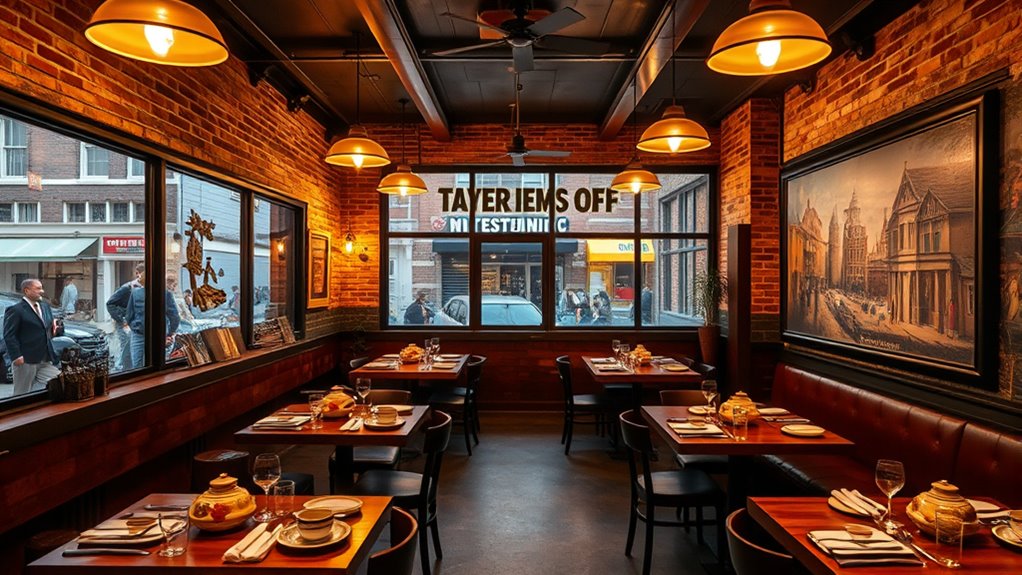
Restoring historic restaurant spaces can strengthen your community’s identity and keep local traditions alive. When you support projects that honor the area’s roots, you foster a sense of pride and belonging. Engaging with these spaces encourages ongoing connections among residents and visitors alike. Implementing best practices in quality assurance during restoration ensures the durability and authenticity of the renovations.
Preserving Local Identity
Preserving local identity during restorations guarantees that communities retain their unique character and cultural roots. When you focus on maintaining authentic elements, you guarantee the restaurant reflects the area’s history and customs. This approach fosters pride and a sense of belonging among locals. To enhance this effort, consider these key actions:
- Incorporate traditional design elements that echo the area’s heritage.
- Use locally sourced materials and craftsmanship to support regional artisans.
- Highlight stories or symbols that represent the community’s history within the space.
Fostering Community Engagement
How can revamping historic restaurant spaces strengthen ties between the establishment and the community it serves? By preserving the building’s character, you create a sense of continuity and pride that resonates locally. Hosting community events, farmers’ markets, or cultural celebrations in these revitalized spaces encourages residents to connect and participate actively. You invite locals to share their stories, traditions, and talents, fostering a sense of ownership and belonging. Additionally, supporting local artists, musicians, and vendors through collaborations enhances community visibility. When you invest in restoring historic venues, you show commitment to your neighborhood’s identity, making it more than just a dining spot—it becomes a gathering place that nurtures relationships and strengthens local culture. Recognizing the importance of community engagement can further deepen these connections and cultivate a shared sense of purpose.
Future Trends in Restaurant Restomod

As the restomod movement continues to evolve, future trends are likely to focus on integrating sustainable practices and cutting-edge technology to enhance both aesthetics and functionality. You’ll see more restaurants adopting eco-friendly materials, energy-efficient systems, and waste reduction methods. Additionally, smart technology will become central, enabling seamless reservations, personalized dining experiences, and contactless payments. Here are three key trends to watch: 1. Green Renovations – Using reclaimed materials and renewable energy sources for eco-conscious restorations. 2. Smart Integration – Incorporating IoT devices for maintenance, ambiance control, and customer engagement. 3. Adaptive Designs – Creating flexible spaces that can easily transform for different events or evolving needs. The incorporation of sustainable practices will be essential for future success in restaurant restomods. These trends will shape the future of restaurant restomods, blending history with innovation.
Frequently Asked Questions
How Do Restaurateurs Choose Which Historic Spaces to Restore?
When choosing which historic spaces to restore, you consider factors like location, architectural significance, and potential for attracting customers. You evaluate the building’s condition and historical value, ensuring it aligns with your brand. You also think about zoning laws, renovation costs, and how the space can be modernized while preserving its charm. Ultimately, you pick a site that balances preservation with profitability, creating a unique dining experience.
What Are the Cost Implications of Restomodding Versus New Construction?
You might find that restomodding a historic space can be a more nuanced investment than new construction. While it often involves higher upfront renovation costs due to preservation needs, it can also attract a loyal clientele and boost your brand’s charm. New builds may have lower initial expenses but could lack the unique character that draws in customers. Weigh these factors carefully to decide which path aligns best with your vision and budget.
How Do Restomod Projects Comply With Modern Building Codes?
You need to guarantee your renovation project follows current building codes. This involves working with local authorities early, submitting detailed plans, and possibly upgrading systems like electrical, plumbing, and fire safety to meet modern standards. You should hire professionals experienced in historic restorations, as they understand code requirements and how to integrate them seamlessly into the existing structure. Regular inspections will help keep your project compliant throughout its development.
What Role Does Sustainability Play in Restomodding Historic Restaurants?
Sustainability plays a vital role in restomodding historic restaurants by guiding you to use eco-friendly materials and energy-efficient systems. You can incorporate solar panels, LED lighting, and sustainable insulation to reduce environmental impact while preserving the building’s charm. This approach helps you meet modern standards, lowers operational costs, and appeals to eco-conscious guests, ensuring the space remains functional and relevant for years to come.
How Do Restomod Efforts Impact the Restaurant’S Original Architectural Integrity?
Imagine restoring a vintage car, where careful attention preserves its core character. Restomod efforts can either enhance or threaten a restaurant’s original architecture. You might choose authentic materials that honor the past, or modern updates that overshadow historic details. When done thoughtfully, you maintain the building’s charm. But if rushed or overly altered, the original integrity risks erasure, like a faded photograph losing its clarity. Your approach determines whether history remains visible or fades away.
Conclusion
As you step into a restomodded restaurant, you can feel the perfect blend of history and innovation. The space whispers stories of the past while inviting you to experience something fresh. But behind the scenes, choices echo with challenges—balancing preservation with progress. Will these revitalized gems continue to honor their roots or redefine the future of dining? The answer lies in what’s next for these dynamic spaces, waiting to surprise and inspire you at every turn.



